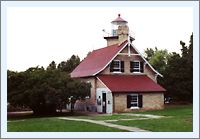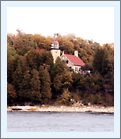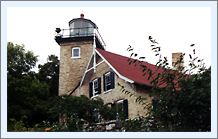|
Historical
Information

With increasing settlement north of Sturgeon Bay in the mid 1860ís,
there was a corresponding growth in the volume of maritime traffic
passing through the channel between the Strawberry Islands and the
mainland in the area of Fish Creek. To light this passage, the
Lighthouse Board requested an appropriation for the establishment of a
Light on Eagle bluff in its annual report for 1865. Congress responded
with an appropriation of $12,000 for the stationís construction in
1866, and with plans for the station drawn up the following winter,
construction was expected to commence with the opening of the 1867
navigation season.
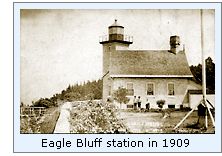 However, with lighthouse construction on the lakes reaching a
feverish pitch, work crews were taxed to complete all of the projects
for which appropriations had been made, and the work crew scheduled for
the Eagle Bluff project was redirected to Escanaba to begin construction
of the Sand Point Light. Thus, construction at Eagle Bluff was postponed
until the Spring of 1868, when a work crew finally landed with the
necessary supplies to commence construction. However, with lighthouse construction on the lakes reaching a
feverish pitch, work crews were taxed to complete all of the projects
for which appropriations had been made, and the work crew scheduled for
the Eagle Bluff project was redirected to Escanaba to begin construction
of the Sand Point Light. Thus, construction at Eagle Bluff was postponed
until the Spring of 1868, when a work crew finally landed with the
necessary supplies to commence construction.
After blasting-out the basement from the solid rock, a 9' 4"
square tower and attached 26' x 30' two-story keepers dwelling were
erected of cream city brick atop the bluff. While following the same
overall plan as employed in the Chambers Island
light, the tower shape
was modified to be square in plan, so as to provide a noticeably
different day mark. The circular cast iron stairway spiraling within the
tower served as both stairs between the two floors of the dwelling and
as access to the lantern above.
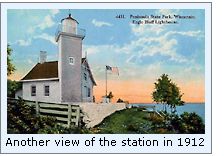 The ten-sided cast iron lantern room, fabricated at the Lighthouse
Deport in Detroit and shipped to the site in sections, was reassembled
on top of the tower. Henry Stanley was appointed as the stationís
first Keeper. After arriving at the station on September 14, Stanley
assisted the construction crew in putting the finishing touches to the
station over the following month. Finally, the District Lampist arrived
to assemble the fixed white Third
and a Half Order Fresnel lens within
the new lantern room. With work on the station thus complete, Stanley
climbed the tower stairs to exhibit the new Eagle Bluff Light for the
first time on the night of October 15, 1868. With a tower height of
forty-four feet, and the stationís dominant location high atop the
bluff, the 860-candlepower lamp within the lens sat at a seventy-six
foot focal plane, and boasted a range of visibility of 15 miles in clear
weather. The ten-sided cast iron lantern room, fabricated at the Lighthouse
Deport in Detroit and shipped to the site in sections, was reassembled
on top of the tower. Henry Stanley was appointed as the stationís
first Keeper. After arriving at the station on September 14, Stanley
assisted the construction crew in putting the finishing touches to the
station over the following month. Finally, the District Lampist arrived
to assemble the fixed white Third
and a Half Order Fresnel lens within
the new lantern room. With work on the station thus complete, Stanley
climbed the tower stairs to exhibit the new Eagle Bluff Light for the
first time on the night of October 15, 1868. With a tower height of
forty-four feet, and the stationís dominant location high atop the
bluff, the 860-candlepower lamp within the lens sat at a seventy-six
foot focal plane, and boasted a range of visibility of 15 miles in clear
weather.
 Life at Eagle Bluff was likely relatively uneventful over the
following twenty-five years, as little mention of the station appears in
district records beyond records of minor repairs being undertaken. 1893
saw the erection of a 16-foot by 24-foot barn for Keeper Stanleyís
horse, and five years later a detached summer kitchen built to the rear
of the dwelling. After delivery of materials too late for construction
in the 1899 season, a work crew returned in 1900 to erect a red brick
oil storage building with iron roof and door to the east of the
dwelling. Life at Eagle Bluff was likely relatively uneventful over the
following twenty-five years, as little mention of the station appears in
district records beyond records of minor repairs being undertaken. 1893
saw the erection of a 16-foot by 24-foot barn for Keeper Stanleyís
horse, and five years later a detached summer kitchen built to the rear
of the dwelling. After delivery of materials too late for construction
in the 1899 season, a work crew returned in 1900 to erect a red brick
oil storage building with iron roof and door to the east of the
dwelling.
After fifteen years at the station, Keeper Stanley accepted a
transfer to Sherwood Point in 1883, with William H Duclon transferred
from the Beaver Head light station to replace him on September 20.
During their thirty-five years at Eagle Bluff, William and Julia Duclon
would raise a family of seven boys at the station before William retired
from lighthouse service in 1918.
 Duclonís replacement, Peter Coughlin arrived at the station just in
time to oversee the replacement of the original Third and a Half Order
lens with a smaller Fifth Order
lens, which he tended until the lens was
automated through the installation of an acetylene light with sun valve
in 1926. Duclonís replacement, Peter Coughlin arrived at the station just in
time to oversee the replacement of the original Third and a Half Order
lens with a smaller Fifth Order
lens, which he tended until the lens was
automated through the installation of an acetylene light with sun valve
in 1926.
The property sat vacant until 1936 when the Lighthouse Service leased
the dwelling to the State Park. In 1960, the Door County Historical
Society received permission to restore and operate the facility as a
museum, and a two and a half year restoration project began, culminating
with the reopening of the building to the public in 1963, the purpose
the building serves to this day.

Keepers of this Light

Click Here to see a complete listing of
all Eagle Bluff Light keepers compiled by Phyllis L. Tag of Great Lakes
Lighthouse Research.

Seeing
this Light

Take Hwy 42 into Fish Creek. Turn west into Peninsula State Park.
Proceed to the Park office and purchase a pass and obtain a map of the
park from the office, and follow the directions on the map to the
lighthouse. Guided tours of the building are offered every half hour.

Contact information

Eagle Bluff Lighthouse
Located in Peninsula State Park, Fish Creek, WI
Telephone: 920.839.2377
Website
www.EagleBluffLighthouse.org
Email:
info@eagleblufflighthouse.org

Reference Sources

Annual reports of the Lighthouse
Board, various, 1865 - 1909
Great Lakes Light Lists, various, 1876 through 1939
Fish Creek Voices, Edited by Edward & Lois Schreiber, 1990
Photographs from author's personal
collection.
Personal observation at Eagle Bluff, 09/11/2000.
Keeper listings for this light appear courtesy of Great
Lakes Lighthouse Research
|
